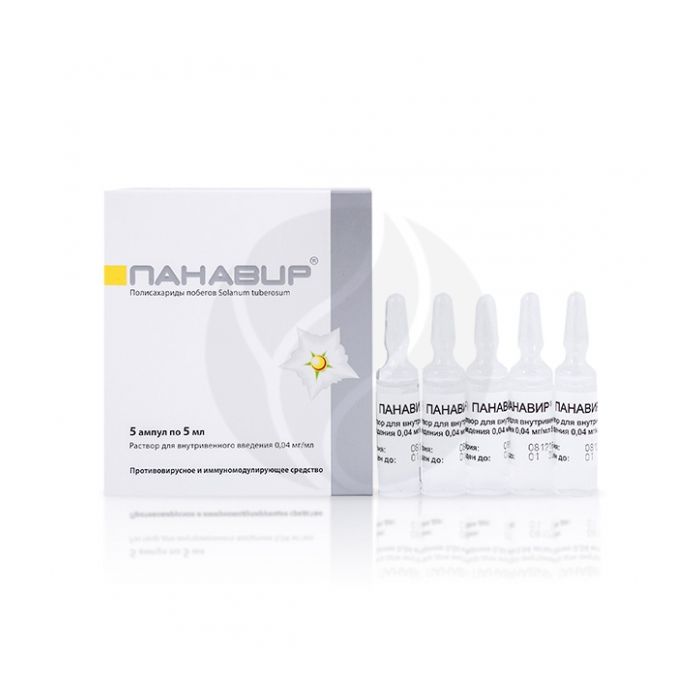Panavir solution for injection 40mkg / ml, 5ml No. 5
Expiration Date: 05/2027
Russian Pharmacy name:
Панавир раствор для инъекций 40мкг/мл, 5мл №5
Herpesvirus infections of various localization (including recurrent genital herpes, herpes Zoster and ophthalmic herpes).
Secondary immunodeficiency states against the background of infectious diseases.
Cytomegalovirus infection, including in patients with recurrent miscarriage. It is used in women with chronic viral infection and interferon deficiency state at the stage of preparation for pregnancy.
Human papillomavirus infection (anogenital warts) as part of complex therapy.
Peptic ulcer of the stomach and duodenum in patients with long-term scarring ulcers and symptomatic ulcers of the gastroduodenal zone as part of complex therapy.
Tick-borne encephalitis in order to reduce the viral load and relieve neurological symptoms (anisoreflexia, reduced reflexes, soreness of the exit points of the cranial nerves, nystagmus) as part of complex therapy.
Rheumatoid arthritis combined with herpesvirus infection in immunocompromised
PanavirЃ should be injected slowly intravenously.
The therapeutic dose of the drug is 200 ?g of the active substance (the contents of one ampoule or vial).
For the treatment of herpesvirus infections and tick-borne encephalitis, it is used twice with an interval of 48 or 24 hours. If necessary, the course of treatment can be repeated after 1 month.
For the treatment of cytomegalovirus and papillomavirus infections, it is used three times during the first week with an interval of 48 hours and twice during the second week with an interval of 72 hours.
For the treatment of gastric ulcer and duodenal ulcer in the acute phase and symptomatic ulcers of the gastroduodenal zone, 5 intravenous injections are used every other day for 10 days.
For the treatment of rheumatoid arthritis, combined with herpesvirus infection in immunocompromised patients, 5 intravenous injections are used with an interval of 24-48 hours, if necessary, repeat the course after 2 months.
For the treatment of acute respiratory viral infections and influenza, 2 intravenous injections are used with an interval of 18-24 hours.
For the treatment of patients with chronic bacterial prostatitis, 5 intravenous injections are used with an interval of 48 hours.
Application in pediatrics
PanavirЃ is prescribed to children from 12 years old at a dose of 100 mcg intravenously 1 time per day.
For the treatment of herpesvirus infections and tick-borne encephalitis, it is used twice with an interval of 48 or 24 hours. If necessary, after 1 month, the course of treatment can be repeated.
For the treatment of cytomegalovirus and papillomavirus infections, it is used three times during the first week with an interval of 48 hours and twice during the second week with an interval of 72 hours.
PanavirЃ (potato shoots extract) -0.04mg / ml;
excipients: sodium chloride - 0.045 g, water for injection - up to 5 ml.
Individual intolerance. PanavirЃ should not be used in patients who are allergic to the components of the drug: glucose, mannose, rhamnose, arabinose, xylose.
Lactation period.
Children under 12 years of age.
Pharmacodynamics
PanavirЃ - purified extract of the shoots of the plant Solanum tuberosum; the main active ingredient is a hexose glycoside, consisting of glucose, rhamnose, arabinose, mannose, xylose, galactose, uronic acids. PanavirЃ is an antiviral and immunomodulatory agent. Increases the body's nonspecific resistance to various infections and promotes the induction of alpha and gamma interferons by blood leukocytes. In therapeutic doses, the drug is well tolerated. Tests have shown the absence of mutagenic, teratogenic, carcinogenic, allergenic and embryotoxic effects. In preclinical studies on laboratory animals, a negative effect on reproductive function and fetal development has not been established. Has anti-inflammatory properties in experimental models of exudative edema,chronic proliferative inflammation and in the test of pseudoallergic inflammatory response to concanavalin A. An analgesic effect was shown in models of neurogenic pain and pain caused by the inflammatory process and thermal irritation. Has antipyretic effect. On the model of parkinsonian syndrome caused by systemic administration of the neurotoxin 1-methyl-4-phenyl-1,2,3,6-tetrahydropyridine, neuroprotective properties have been shown. Has the ability to improve the function of the retina and optic nerve. Possesses wound-healing properties in the conditions of a gastric ulcer model.On the model of parkinsonian syndrome caused by systemic administration of the neurotoxin 1-methyl-4-phenyl-1,2,3,6-tetrahydropyridine, neuroprotective properties have been shown. Has the ability to improve the function of the retina and optic nerve. Possesses wound-healing properties in the conditions of a gastric ulcer model.On the model of parkinsonian syndrome caused by systemic administration of the neurotoxin 1-methyl-4-phenyl-1,2,3,6-tetrahydropyridine, neuroprotective properties have been shown. Has the ability to improve the function of the retina and optic nerve. Possesses wound-healing properties in the conditions of a gastric ulcer model.
Pharmokinetics
When administered intravenously, polysaccharides are found in the blood already 5 minutes after administration, are captured by the cells of the reticuloendothelial system of the liver and spleen. Excretion begins quickly, after 20-30 minutes, polysaccharides are found in the urine and exhaled air.
Side effects
The drug is well tolerated, possible complications may be associated with individual intolerance and hypersensitivity to the components of the drug. At the same time, if any undesirable side effects appear, it is necessary to discontinue the administration of the drug and consult a doctor. If you notice any other side effects not listed in the instructions, inform your doctor.

